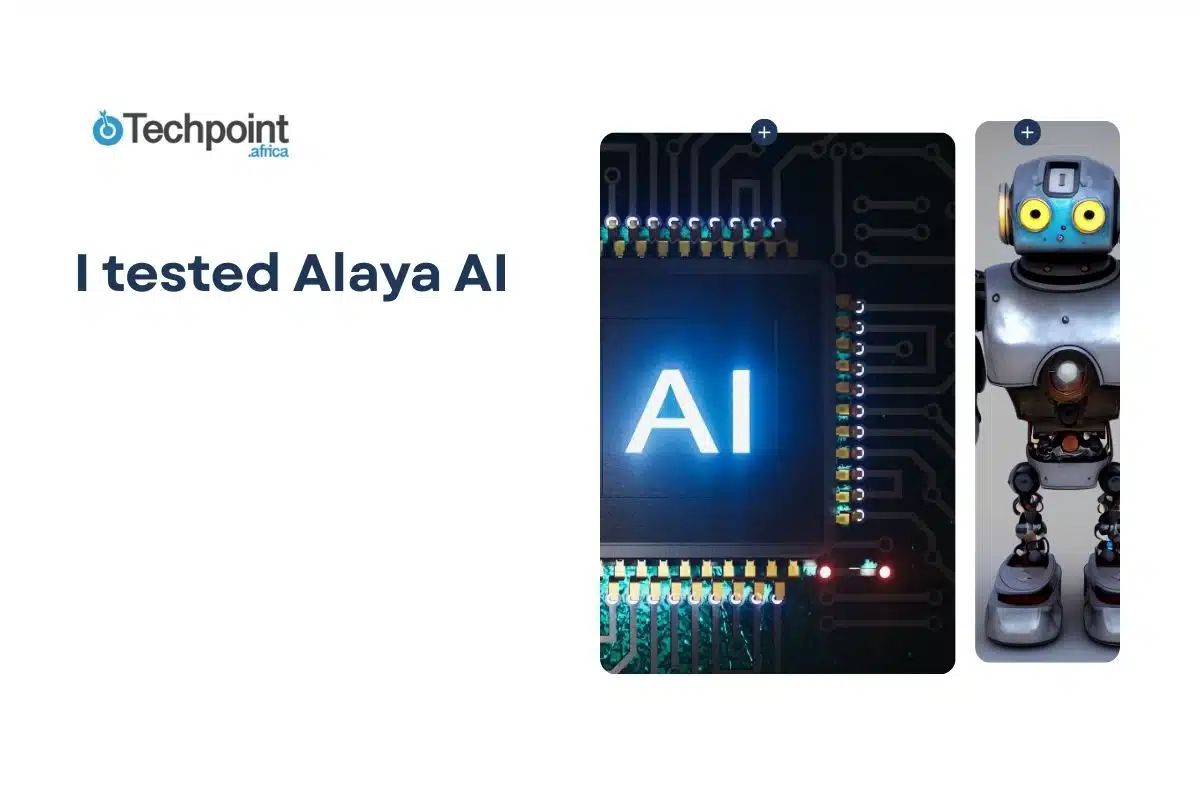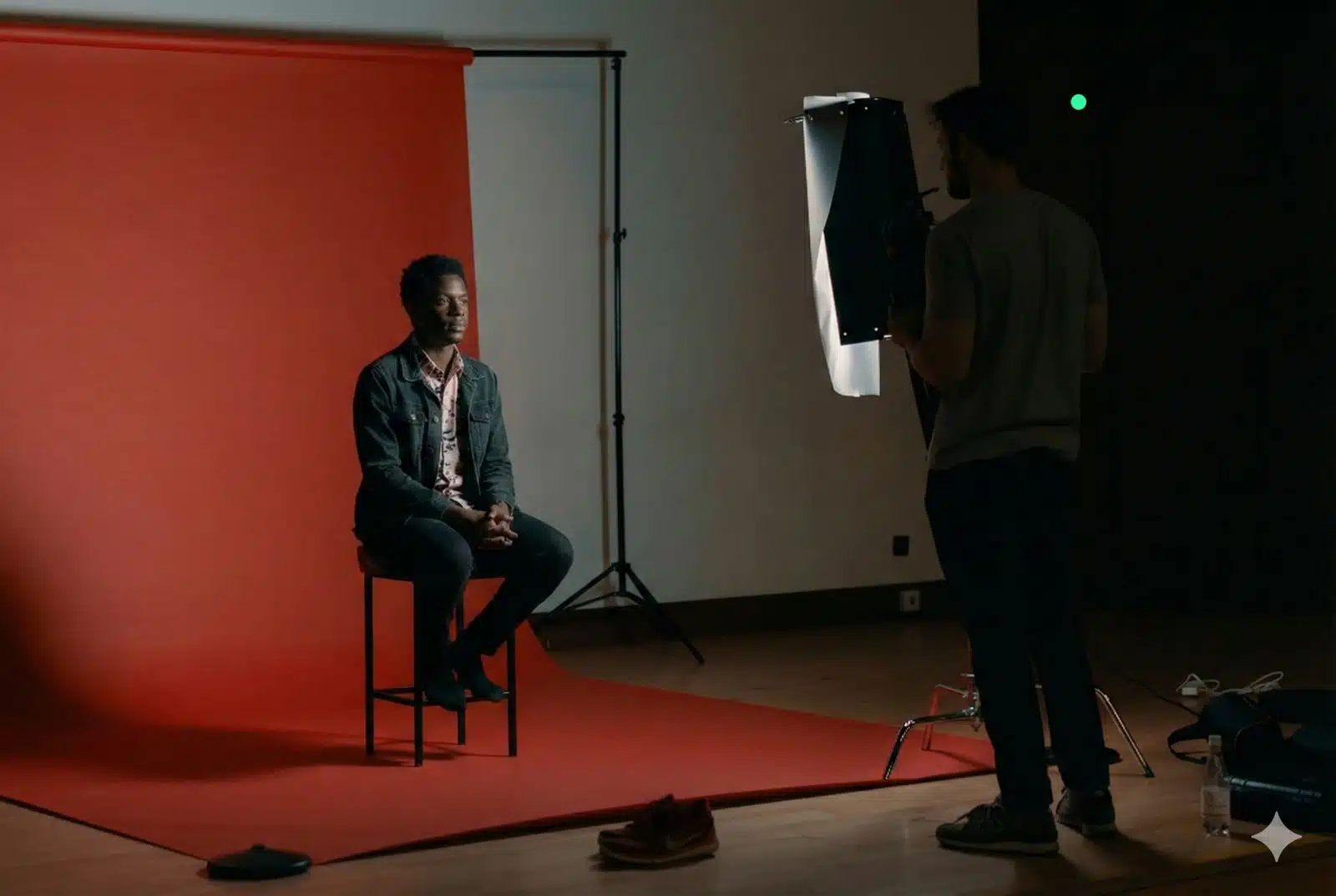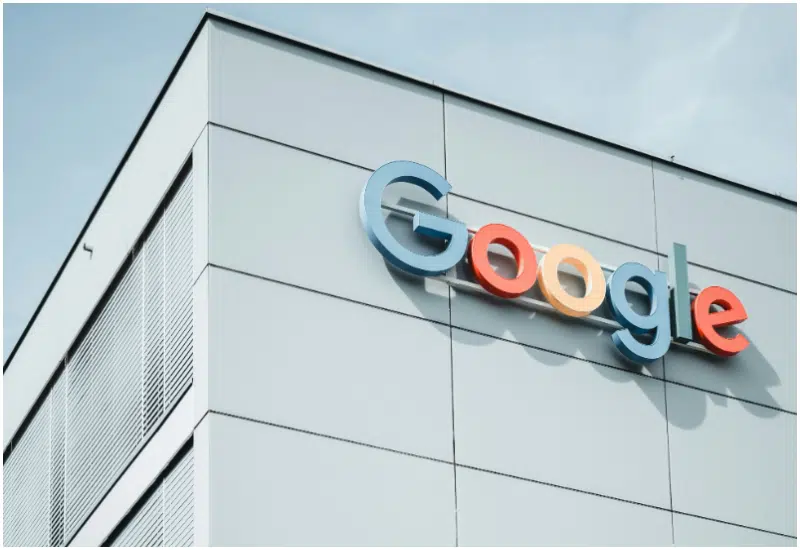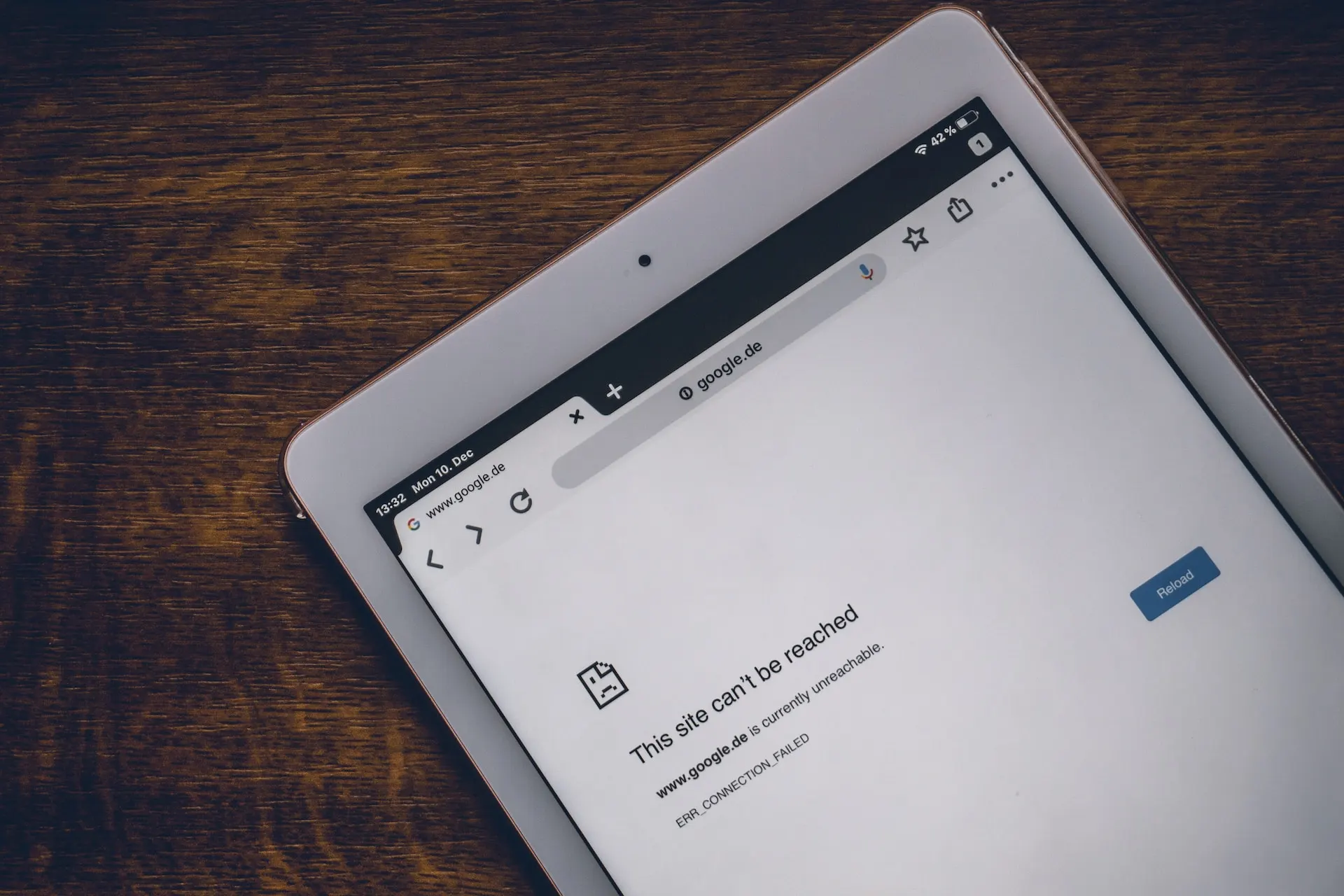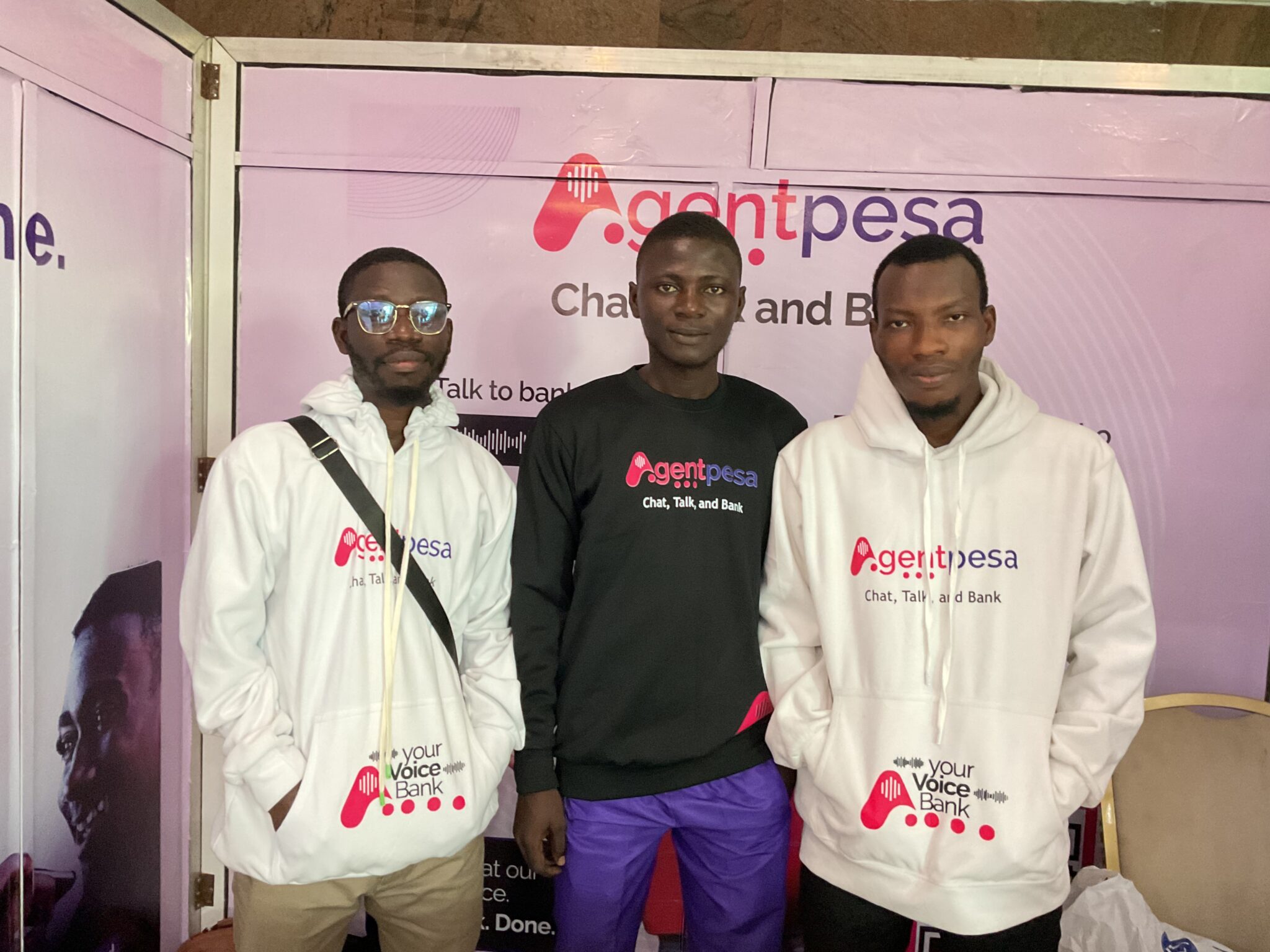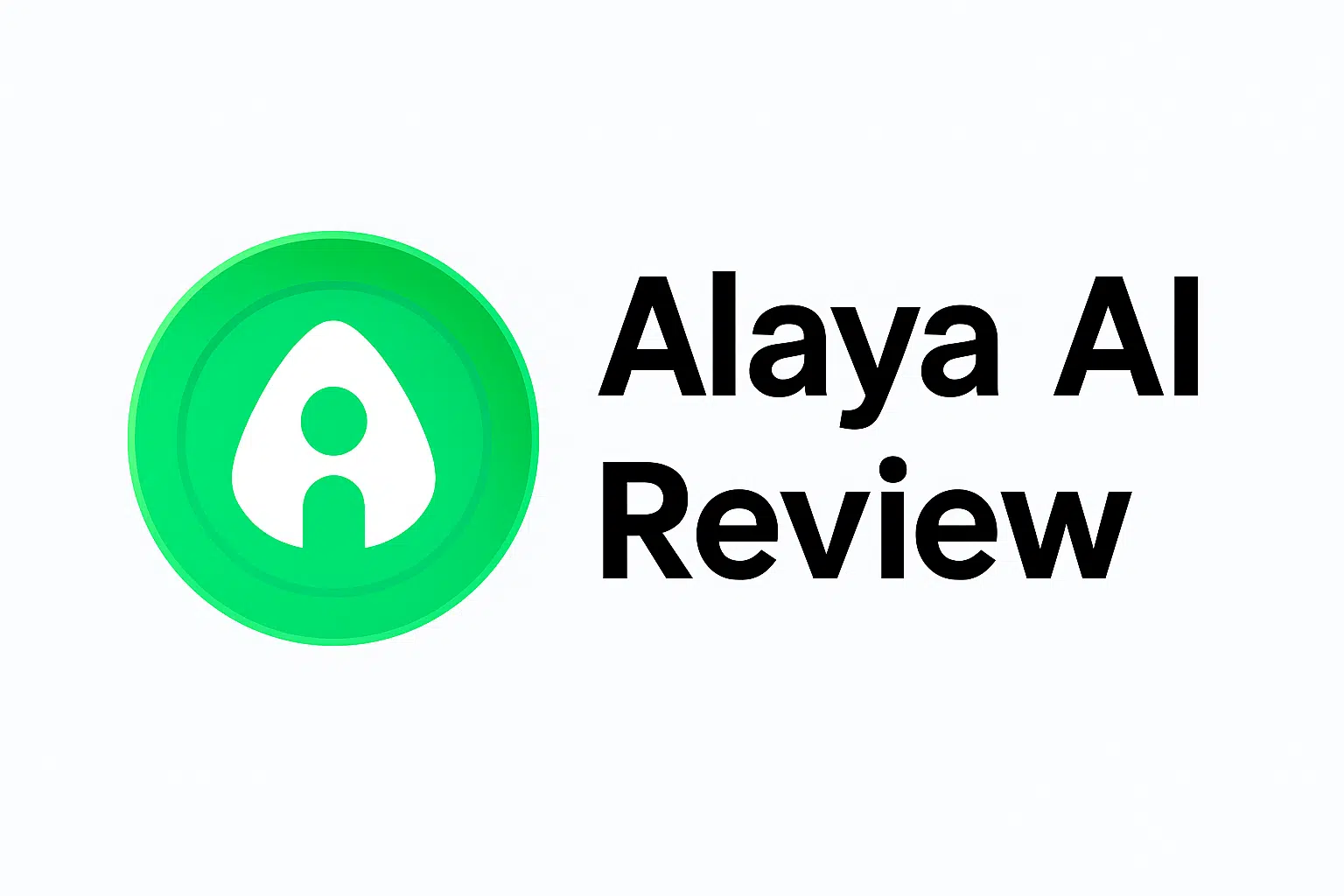
Crypto sounds like hard business, you know?
But with the number of people in crypto right now, that notion is losing its weight really fast. Turns out crypto isn’t as complicated as people make it out to be anymore.
However, just like everything else, crypto is also being affected by AI. And honestly, it’s making things way more interesting. Instead of just buying and selling coins, you can now actually help build AI systems and earn crypto for doing it.
That’s precisely what happened when I discovered Alaya AI. I’m going to write about my first experience with this crypto platform. Was it an authentic promise? A swindling DeFi protocol?
Well, you’d know soon.
In this article, I’ll explain precisely what Alaya AI is and how it works. We’ll look into its key features, explore how the crypto rewards system actually functions, examine its crypto assets and pricing structure, and share my honest experience using the platform. By the end, you’ll know whether Alaya AI is worth your time or just another crypto distraction you should overlook.
Let’s get into it!
Key takeaways from this review
- Alaya AI is a decentralized Web3 platform where users complete microtasks (like labeling data) to help train AI models and earn crypto tokens.
- The platform rewards users with ALA and AGT tokens, plus evolving Contributor NFTs that track your reputation and unlock new features.
- Tasks include image labeling, audio classification, video annotation, text analysis, and even autonomous driving data tagging.
- Alaya uses AI-powered auto-labeling tools and human validation systems (like consensus and double review) to ensure data quality.
- Blind Boxes, contributor streaks, and badges create a gamified experience that encourages consistent and accurate participation.
- Contributors build reputation via a credit system that improves task access and rewards, while protecting against spam or low-quality inputs.
- Alaya has an open data marketplace where companies can access datasets or create custom incentive pools for targeted data collection.
- It supports multimodal AI datasets, making it usable for various industries and AI model types.
- The platform has strong traction, with 3.6 M+ users, 327K daily activities, and 305K daily on-chain transactions as of 2025.
- Staking AGT tokens gives users governance rights and access to premium platform features, though this is optional.
- Alaya provides real data ownership: all activity is recorded on-chain, tied to user wallets, and transparent.
- As of now, Alaya has no publicly listed pricing. Enterprises must contact the team for quotes, while contributors can use the platform for free.
- Alaya is best suited for:
- People who want to earn crypto by helping with AI development
- Developers or companies seeking custom-labeled datasets
- Users interested in decentralized, transparent Web3 ecosystems
- Minor drawbacks include:
- No mobile app (yet)
- Occasional task glitches
- Slight learning curve for non-crypto users
What’s Alaya AI?
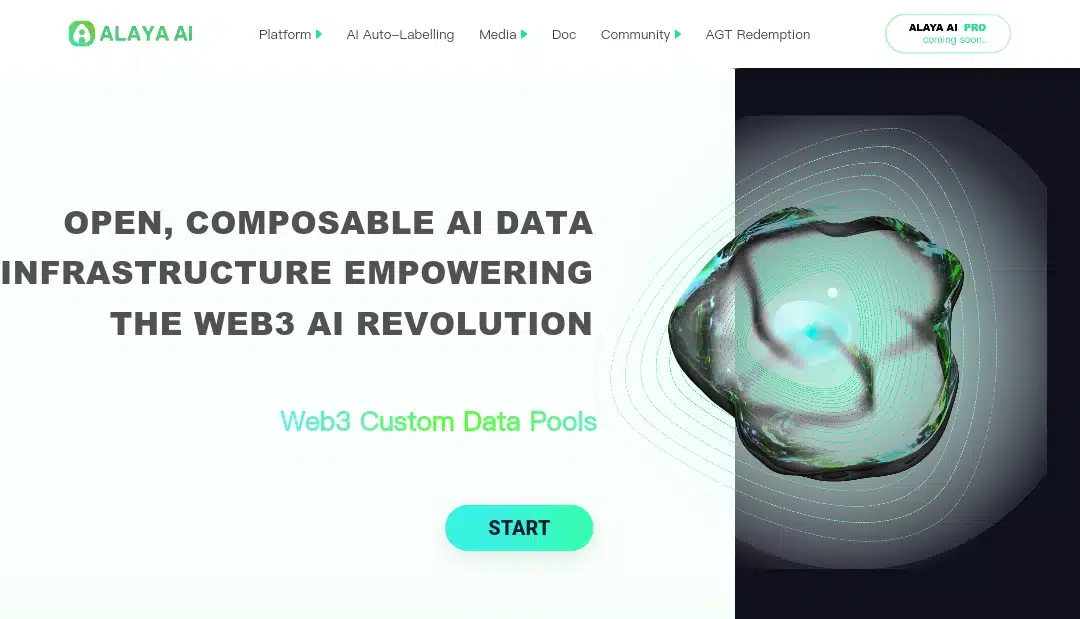
Alaya AI is a decentralized platform allowing individuals to contribute to artificial intelligence development by performing small, human intelligence tasks, such as labeling data or verifying content, and earning cryptocurrency in return. It operates entirely on Web3 infrastructure, so any users’ or contributors’ activities are recorded on the blockchain, your rewards come in tokens, and your identity is tied to a crypto wallet, not a username or email address.
Alaya AI made paying for these activities this way. Modern AI systems are mostly trained using large amounts of labeled data, such as images, audio, text, etc. Traditionally, that data is gathered and labeled by large corporations or behind closed systems. Alaya AI changes things up with that model. Instead of limiting access, it opens up AI training to the public so that anyone with a wallet and an internet connection can contribute and get rewarded. Its AI development is open-source and community-driven.
Because Alaya AI is built on blockchain infrastructure, every contribution you make is trackable, verifiable, and most importantly, owned by you. Over time, your data contributions form part of your digital identity, represented through contributor NFTs. These aren’t just collectibles; they record your reputation and unlock further participation.
In a market where AI data is becoming one of the most valuable digital commodities, Alaya AI positions itself as a Web3-native alternative to closed, centralized AI pipelines. It lowers the barrier to participation, gives people control over the value they create, and introduces financial incentives without relying on ad models, middlemen, or corporate control.
Let’s look at the features that hold Alaya AI together.
Alaya AI features
It was easy to think of Alaya as just a “task-for-token” site, but the longer I stayed on its homepage and watched YouTube testimonial videos, the more I realized it was much more than that. It’s actually built as a composable AI data infrastructure where developers, enterprises, and everyday contributors can all use it in different ways.
One of the standout features is the AI Data Auto-Labelling Toolset. Instead of relying only on human input, Alaya uses its own proprietary tools to automatically label data. Human contributors like me still play a role (especially when it comes to validation and improving quality), but the auto-labeling tools make the process faster and more scalable. This helps enterprises get structured data at lower costs and gives contributors more interesting, precision-based tasks.
Another strength is that Alaya supports multimodal datasets. That means it’s not limited to just text or images, but it covers a broad range of data types, including:
- Image labeling
- Audio analysis
- Autonomous driving data
- Text classification and analysis
- Video annotation
These tools allow AI developers to train models across diverse domains, whether for self-driving cars, smart assistants, or content moderation. From my side as a contributor, it also means the tasks won’t feel repetitive but will actually reflect the variety of data real-world AI needs.
Alaya AI differs from most Web3 platforms because it offers an open, composable data infrastructure. That enables developers and researchers to plug into it to request custom data or build incentive layers using smart contracts. For example, an organization could create its own reward pool to collect specific kinds of data through the platform (like healthcare images, product reviews, or localized speech recordings), while letting the contributor community earn from it.
This is part of what Alaya calls its distributed AI data ecosystem.
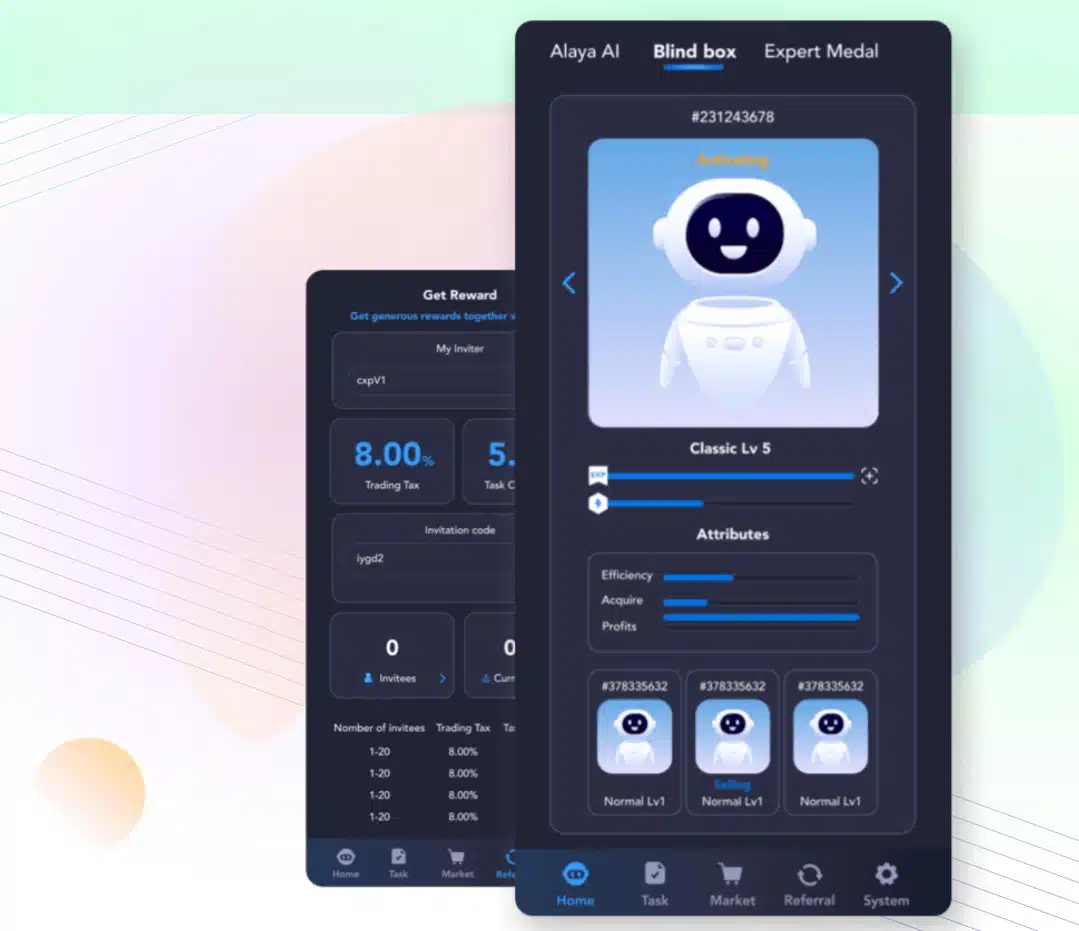
The idea is to combine the flexibility of Web2 with the transparency and incentive structures of Web3. Users like me contribute labeled data and earn tokens, while buyers or developers use that data to improve their models, all within a decentralized and transparent framework.
Alaya also runs an open data marketplace.
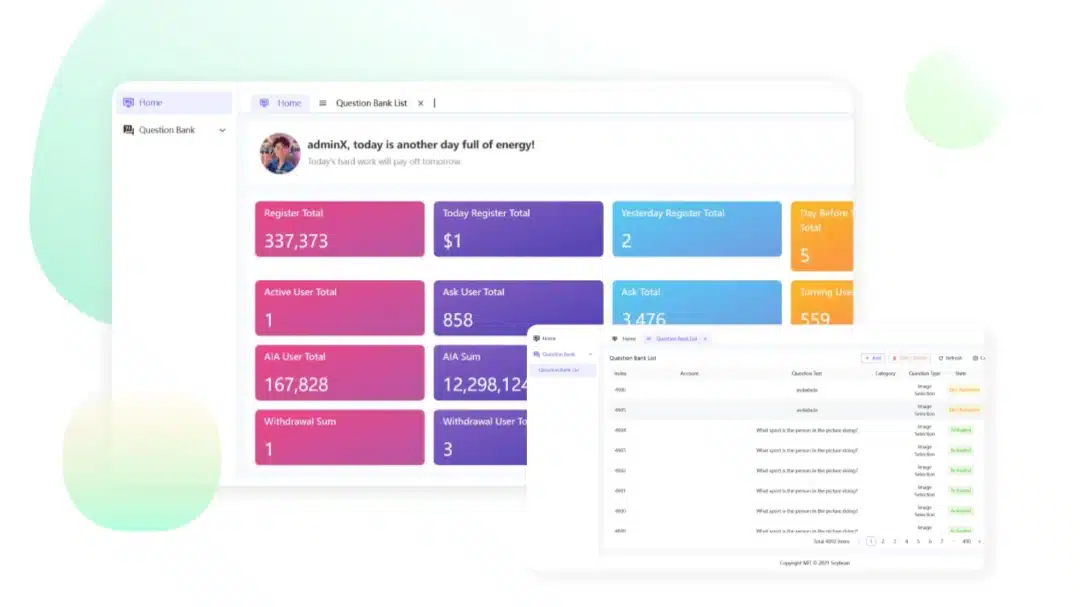
This allows datasets to be traded or accessed with custom rules, either on-chain (using smart contracts and cryptocurrency payments) or off-chain (for companies that require private datasets). The ability to bootstrap datasets organically and reward contributors directly makes it a strong alternative to centralized data providers, such as Scale AI or Amazon Mechanical Turk.
In addition, Alaya’s infrastructure supports swarm intelligence-inspired sampling, which ensures data is selected and distributed based on collective behavior and reinforcement learning, not randomness. This helps improve efficiency and reduce noise in the dataset.
Let’s head into the signing-up process and see how earning a task works.
My Alaya AI signup experience
I explored Alaya AI by tapping the “Start” button on the homepage. This led me to a registration form where I needed to enter my email address. I also noticed a blockchain selection dropdown showing “opBNB” as the selected option.
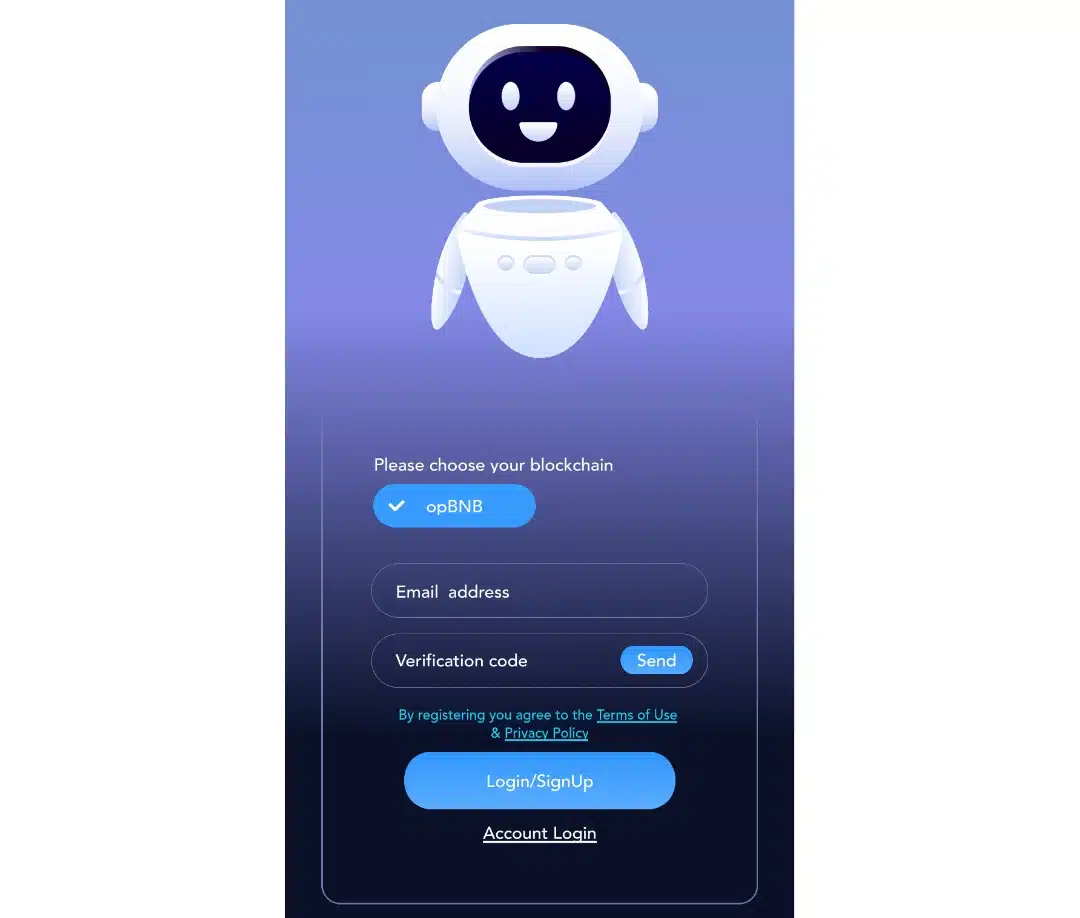
After filling in my email, I was prompted for a verification code, so I headed to my email inbox, found the verification number, copied it, and pasted it back into the form.
Once I successfully verified my email, I was greeted with a welcome screen that said “Welcome to the Alaya World!”
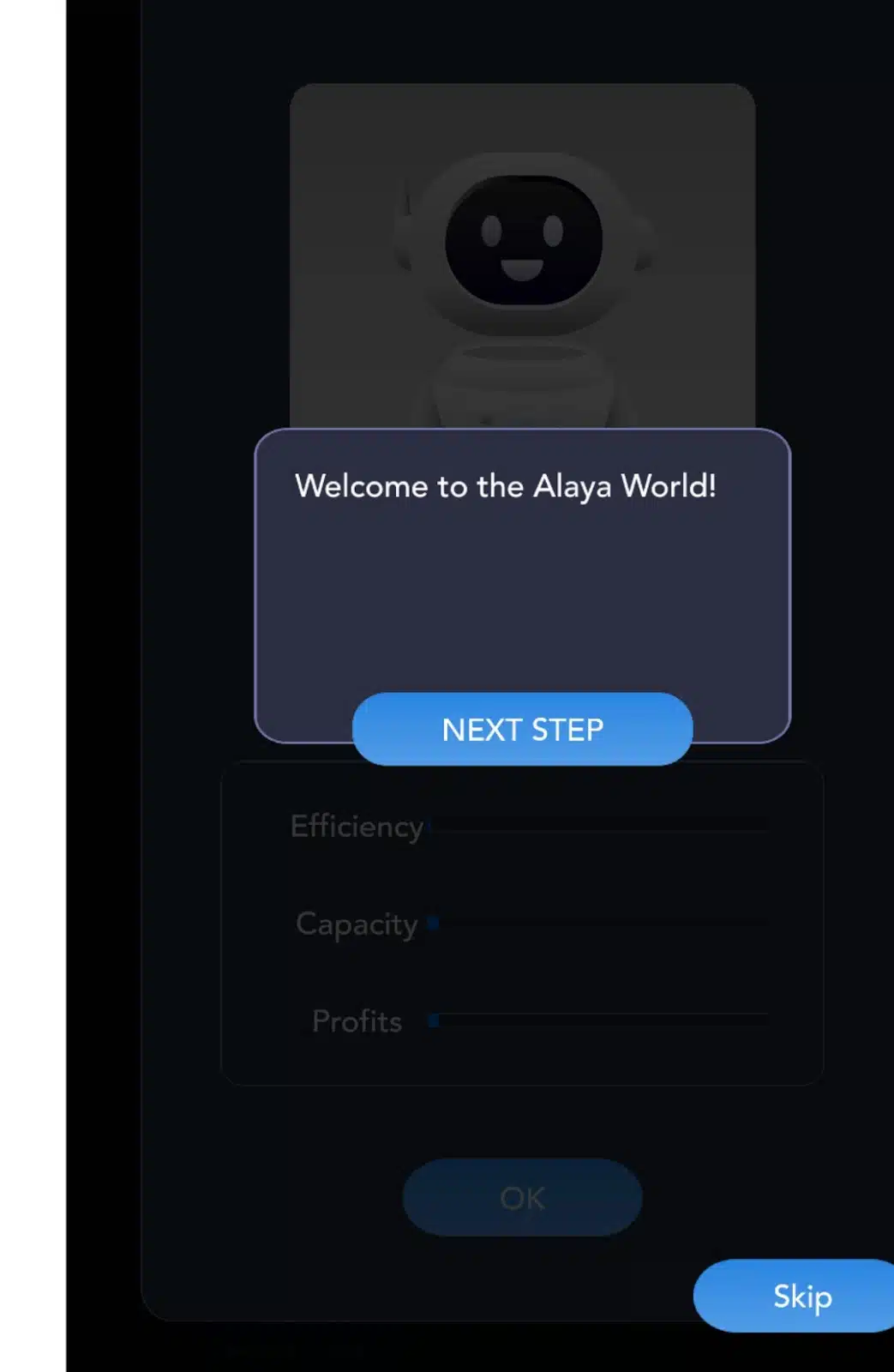
The interface featured the same cute robot mascot I’d seen earlier, and there was a prominent blue “NEXT STEP” button waiting for me. Below that, I could see some metrics or progress indicators showing “Efficiency,” “Capacity,” and “Profits” – though these appeared to be empty or at zero since I was just getting started.
Clicking “NEXT STEP” brought me to what appeared to be an AI selection screen. The interface showed me a robot character marked as “Selected” and labeled as “Normal Lv 1.” An explanatory text told me: “You have obtained your exclusive Alaya AI. Click on Task to execute training tasks for your AI NFT.”
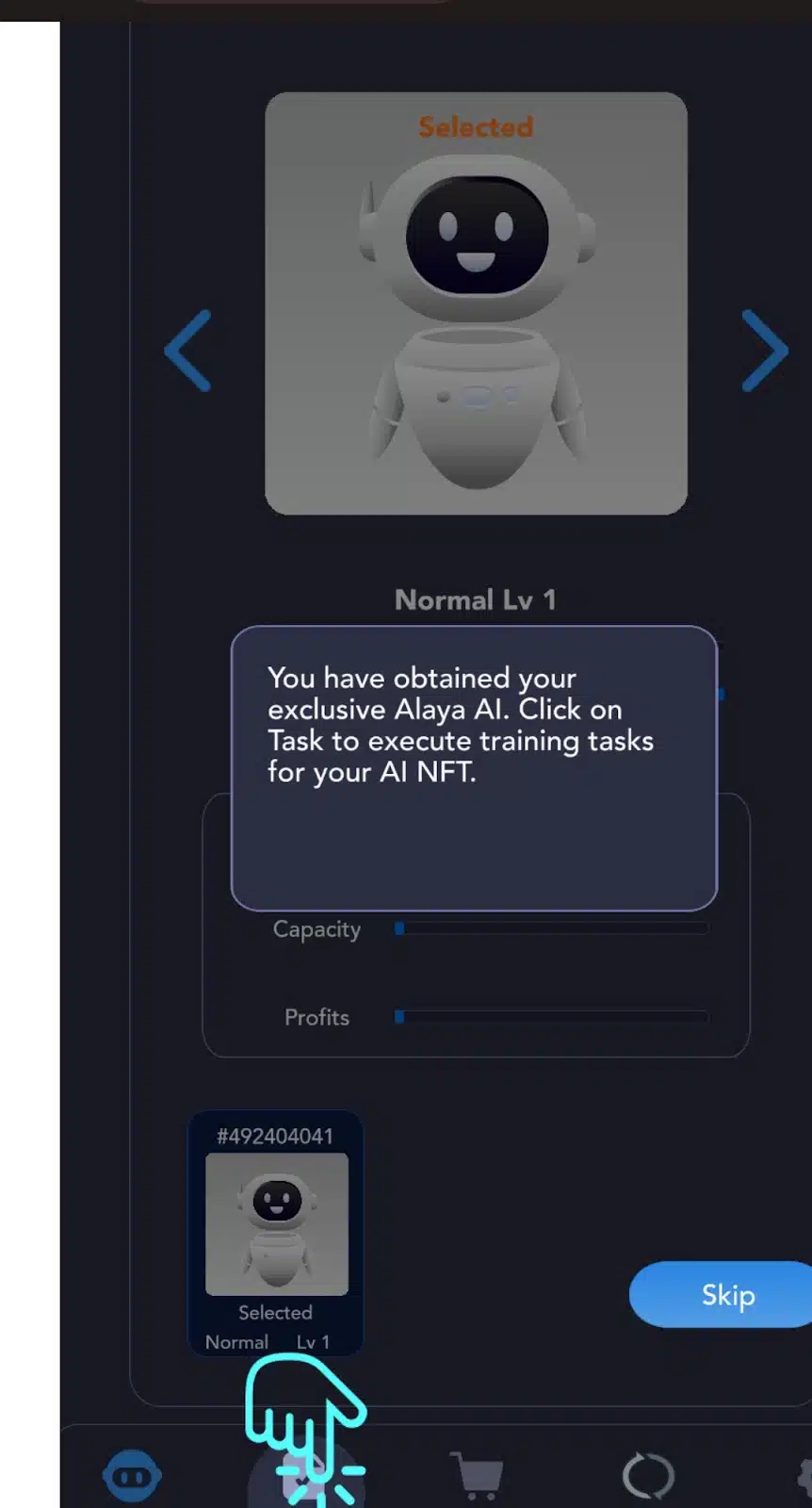
I could see navigation arrows on either side, suggesting there might be other AI options to browse through. At the bottom were progress bars for “Capacity” and “Profits.” The robot had an ID number of 492404041, and a “Skip” button was in the corner if I wanted to move forward quickly.
The next screen introduced me to the task system, which has different categories displayed as tabs: Certify, Active, Routine, Senior, and Expert. I was currently on the “Certify” tab, which showed “Group 1” with “5 Questions.”
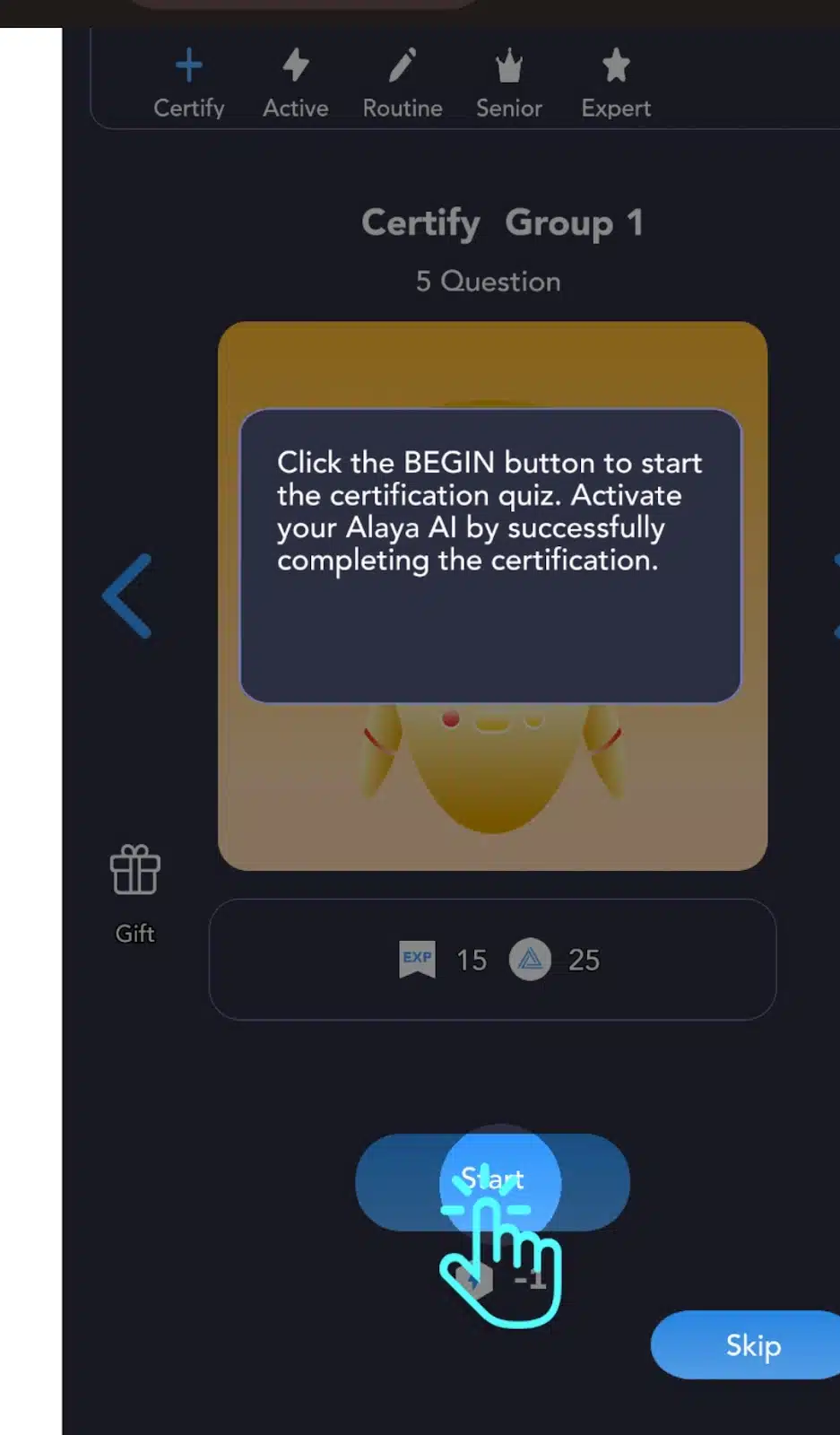
The interface explained: “Click the BEGIN button to start the certification quiz. Activate your Alaya AI by successfully completing the certification.” A reward system showed “15 EXP” and “25” of some other currency or points. A large blue “Start” button was ready for me to begin my first certification attempt.
I tapped “Start” and was immediately presented with my first question. It was a video-based question asking, “What are the people in the video doing?” The video showed someone in a green shirt standing on what appeared to be a football field near a goal post. The multiple choice options were:
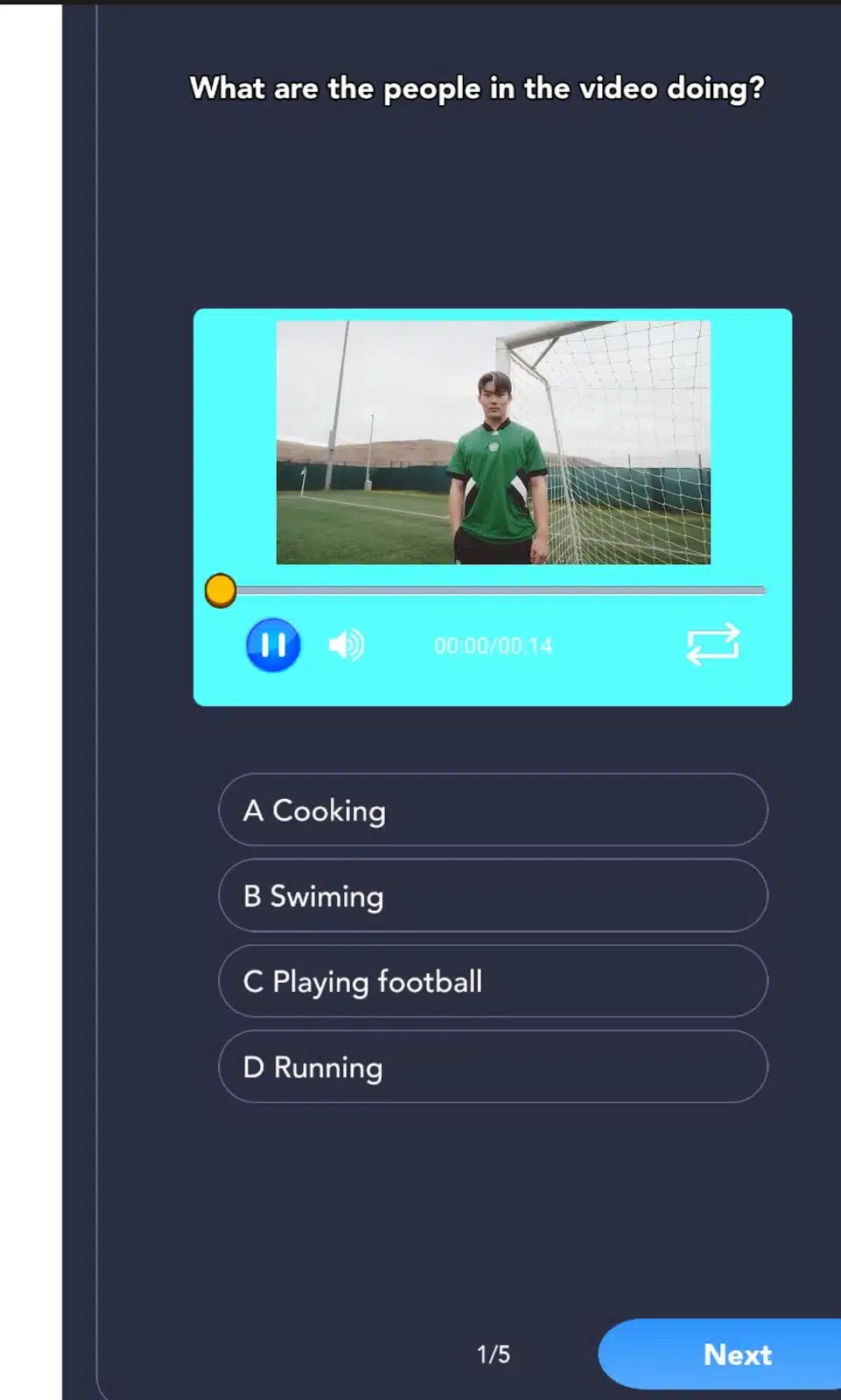
- Cooking
- Swimming
- Playing football
- Running
This seemed straightforward – clearly the answer was C, Playing football, given the football field setting and goal post visible in the video.
The next question was more challenging. It showed a distorted text image and asked me to “Please select the option with the same content as the picture.” The image appeared to show some kind of warped or stylized text, and I had to choose between:
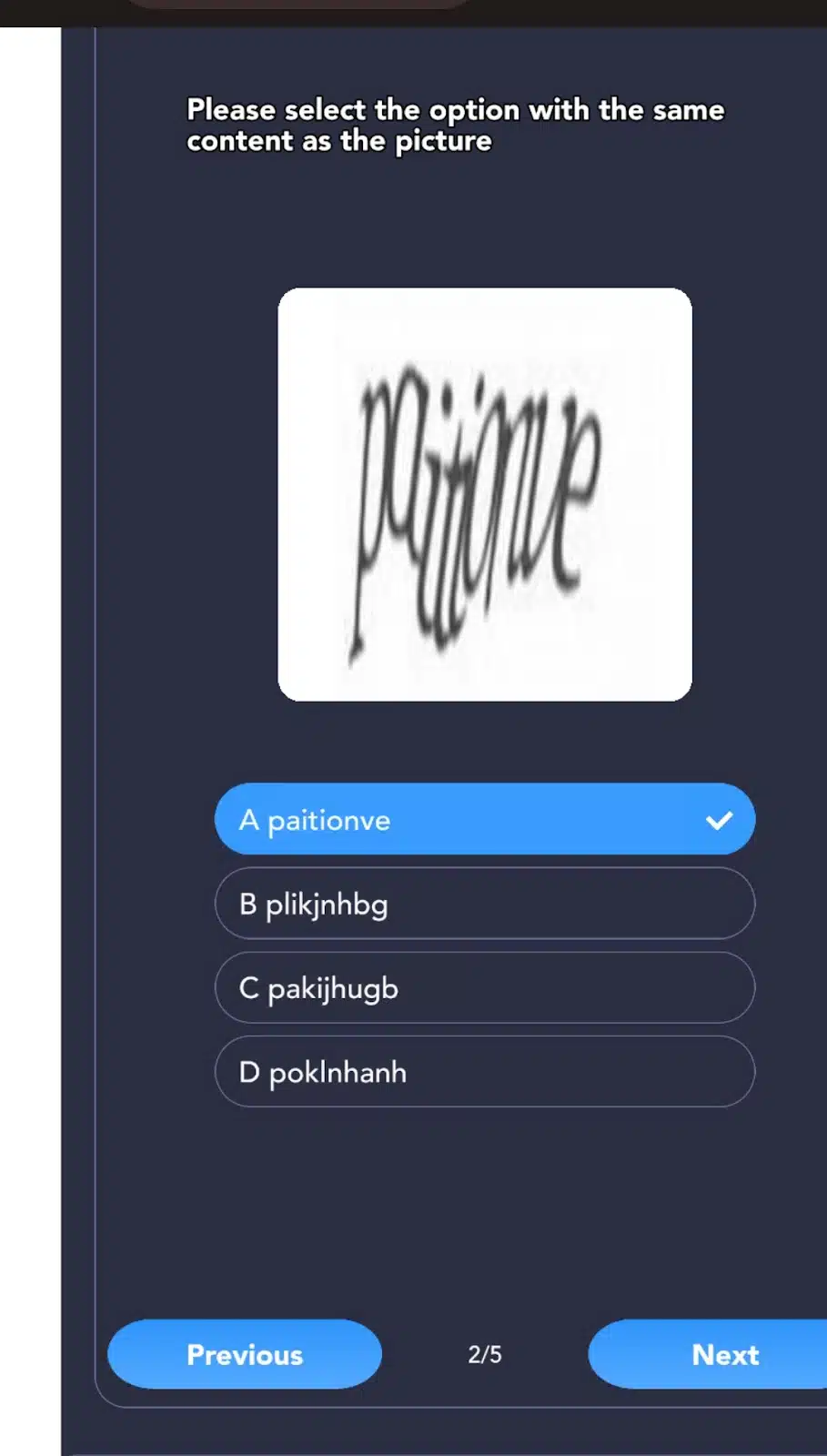
- paitionve
- plikjnhbg
- pakijhugb
- pokInhanh
This was clearly a CAPTCHA-style verification test to ensure I was human and could read distorted text.
Question three was a logic puzzle: “Which word is the odd one out?” with options:
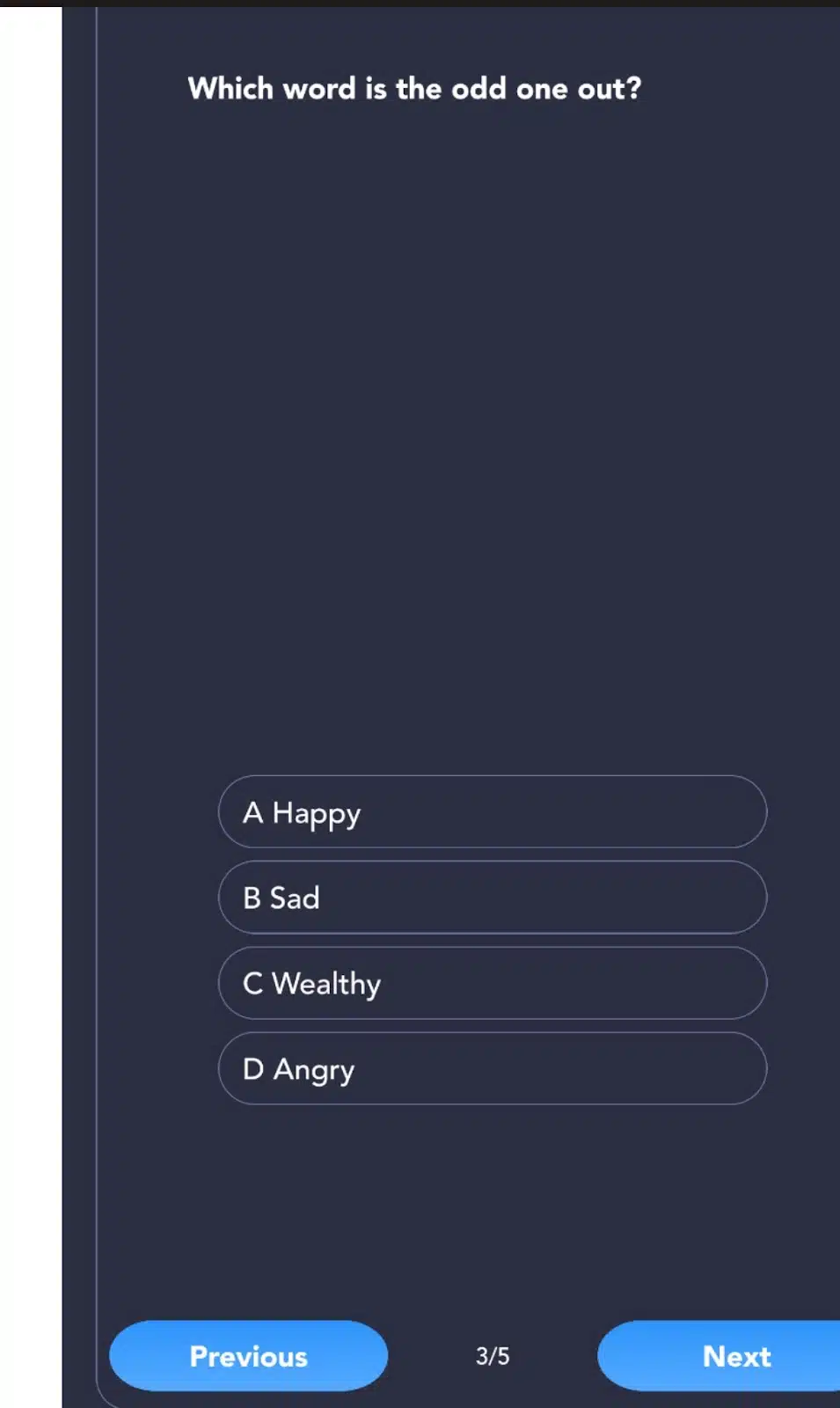
- Happy
- Sad
- Wealthy
- Angry
I had to think about this one. Happy, Sad, and Angry are all emotions, while Wealthy relates to financial status. So C, Wealthy, would be the odd one out.
The fourth question showed me a photo of a smiling person and asked me to judge their emotions. The question was “Judging the emotions of the characters in the picture” with options:

- optimistic
- sad
- peaceful
- Nature
The person in the photo was clearly smiling and appeared happy, so A, optimistic, seemed like the most appropriate answer.
The final question was quite different – it showed what appeared to be a nighttime street scene with people and tents, and asked “Does the following image content contain broken items?” with simple options:
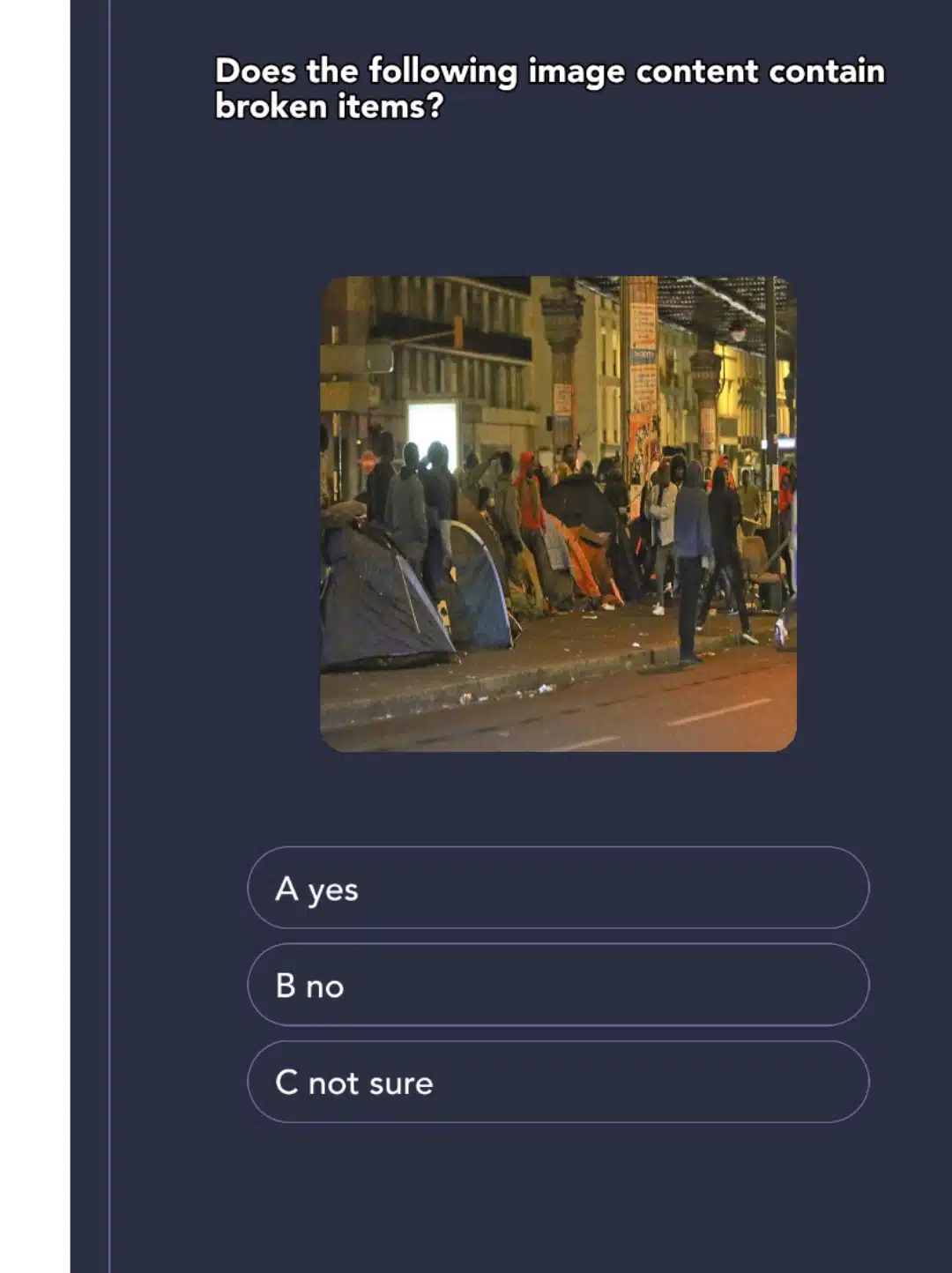
- yes
- no
- not sure
I had to carefully examine the image to determine if any visibly broken or damaged items were in the scene.
After completing all five questions, I was presented with a “Certification Success” screen. The message read: “You have completed one certify attempt. Success grants access to the active question bank, while failure requires trying the certification again.” There was a blue “OK” button to acknowledge my success, and I could see a “Skip” option in the corner.
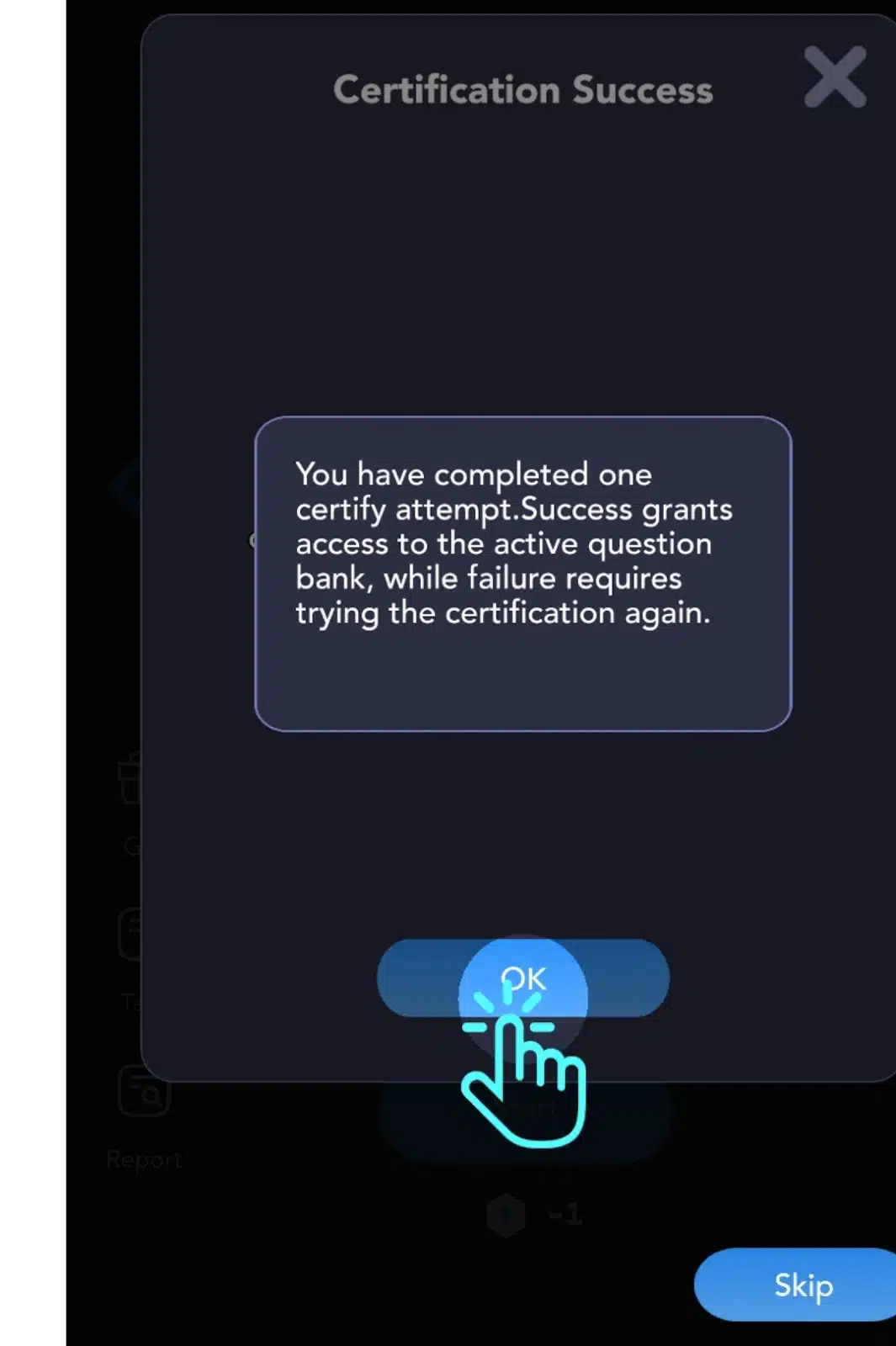
The entire process was quite engaging; it felt like a mix of basic AI training tasks, human verification tests, and cognitive assessments. The gamified approach with the cute robot mascot, progress bars, and reward system made what could have been a mundane signup process feel more like an interactive game. I was curious to see what the “active question bank” would contain and what other tasks I could perform to train my AI NFT and earn more rewards.
How earning with tasks works in Alaya AI
Once my account was ready, I had to go straight into the tasks. Alaya AI calls these “contributions,” which are the main way you earn tokens. At first, I didn’t know what to expect. Would I be writing articles? Solving puzzles? It turns out most of the work involves data labeling, validation, or short human input tasks.
The first set of tasks I saw was simple: tagging emotions in photos, identifying objects in short video clips, or confirming whether a statement made sense. These were under the “Daily Task” section, and you could tell they were designed to be finished quickly; most took under two minutes. There’s a timer that shows how long you’ve taken, but there’s no pressure to rush. Each task shows a token reward amount next to it.
One of my first tasks was voice clip validation. Alaya AI played an audio file ( just a few seconds long) and asked me to confirm whether the transcription matched. I had to pick “Yes,” “No,” or “Not sure.” After submitting, it thanked me and updated my reward tally.
What stood out early on was how repetition builds rewards. After a few tasks, I unlocked a “Blind Box”, a small pop-up animation that told me I’d earned some ALA tokens. These boxes feel like mini jackpots and are designed to keep you motivated. Some blind boxes contain just a few tokens, others include NFTs, bonus points, or badges.
The system also tracks your task accuracy over time. Alaya AI compares your answer to others who did the same task whenever you label something. If you match the majority, you get full credit. You may lose part of the reward or get flagged if you’re off. This validation method, called consensus scoring, helps prevent spammers or low-quality work from earning tokens.
I quickly noticed that some tasks were locked unless I had contributed better NFTs or staked tokens. That’s where the leveling system comes in. By doing tasks accurately, you gain a reputation. Reputation leads to unlocking “Advanced” or “Expert” tasks, which pay more. These included analyzing news headlines for sentiment or labeling specific parts of medical images. I couldn’t access these right away because I’d need to keep contributing and possibly stake tokens later to unlock them.
One thing I appreciated was the variety of tasks. I didn’t get bored easily. Some tasks were image-based, others were audio or text. A few even felt like surveys asking my opinion on simple topics or ranking answers in order of relevance. These made me feel like I wasn’t just working blindly for tokens but helping improve AI models that understand human behavior and language.
In terms of earnings, I tracked my progress over a few hours. For roughly 20–30 tasks, I earned the equivalent of a few dollars in AGT/ALA tokens (depending on market value). It’s not a full-time income but fair compensation for micro-contributions. And since Alaya AI is still growing, token values and task payouts may change over time.
I also saw the referral system. From what I read, you earn a percentage of what your referrals make, around 12%. That means there’s potential to build a small team of contributors and benefit passively, though I didn’t test this personally.
Overall, the task system felt polished and functional. It wasn’t perfect ( sometimes a task glitched or didn’t load fully), but the overall experience was smooth. It felt like a platform with real utility, not just a Web3 experiment.
For anyone willing to spend 10–30 minutes a day, Alaya AI offers a fair and decentralized way to earn crypto by helping train AI. And if you put in consistent work, the system rewards you over time with more tasks, better earnings, and a growing reputation
How Alaya AI plays fair to contributors (On Validation, Rewards & Reputation)
One of the things I paid close attention to while using Alaya AI was how it keeps the system fair. Since this is a decentralized platform where people earn tokens, there’s always a risk that users might attempt to cheat or spam the system in order to collect rewards. However, Alaya actually has a layered system in place to maintain balance, and I observed its effectiveness while completing tasks.
The first layer is task validation through consensus. That means the same task gets sent to multiple users. Your answer is accurate if your response matches what most other contributors say. If you regularly disagree with the majority, your accuracy score drops. This isn’t random. Alaya is actively measuring how well you align with other human validators. I noticed that I got a small warning message when I made a mistake, and my reward was slightly reduced.
There’s also a credit rating system. This score builds over time as you do more tasks. The more accurate you are, the higher your rating. This credit score unlocks more advanced jobs and helps protect your account from being unfairly penalized. If your credit drops too low, certain earning features can become restricted. I liked that Alaya AI didn’t harshly punish small mistakes, but also didn’t allow low-effort contributors to skate by.
Another feature is double validation. Sometimes, Alaya AI uses two or more reviewers to validate a single entry, especially with higher-level tasks. For example, if someone uploads a labeled image, another person might be asked to verify that those labels are correct. Only after verification will the reward be finalized. This extra step helps protect the platform from people who might try to upload junk just to farm tokens.
Rewards are not always fixed; they scale based on difficulty, task type, and your reputation. I noticed that simple tasks gave fewer tokens, while validation tasks (where you double-check others’ work) often paid more. There’s also a time-based element: if you’re consistent daily, your contribution streak increases your blind box chances.
Alaya AI also encourages fairness through gamification. You earn badges, and progress bars fill up and unlock new features as you complete tasks. These visual incentives push you to stay active and accurate. It might feel like a game, but it’s designed to keep the data quality high without feeling boring.
I never felt like the system was rigged or that others could cheat and get ahead. There’s no manual grading by admins, just collective human intelligence backed by blockchain tracking. Everything I did was recorded, transparent, and open for verification.
Overall, Alaya’s fairness comes from a smart balance between automation, community scoring, and transparent rules. You earn more by being accurate, helpful, and active, not exploiting the system. That gave me more confidence to keep contributing.
The crypto side of Tokens, NFTs, and Staking explained
Before testing Alaya, I had some experience with crypto wallets, but I didn’t know much about how tokens and NFTs would actually work on a platform like this. Once I got into it, I realized that understanding the crypto side of Alaya AI is essential; it’s how everything runs in the background. But thankfully, the platform keeps things reasonably simple, even for someone who isn’t deep into blockchain.
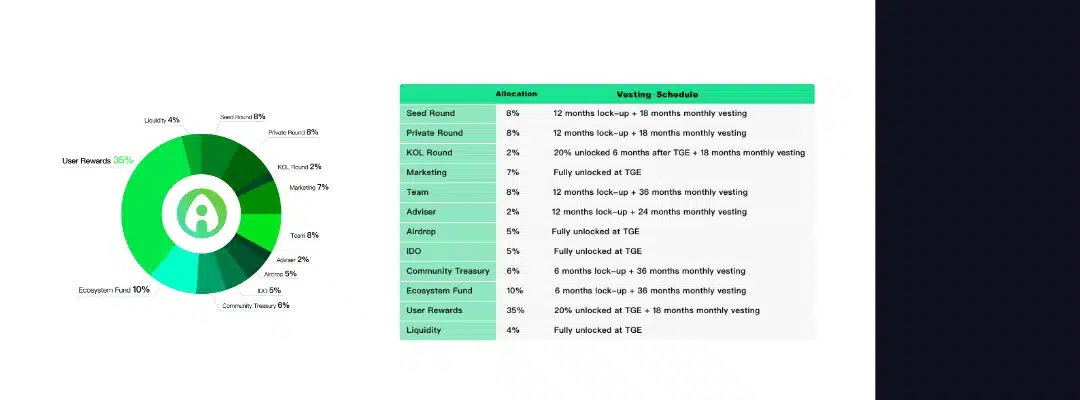
The two primary tokens on Alaya are ALA and AGT. ALA is the native utility token used for platform rewards, transactions, and purchases. AGT (Alaya Governance Token) is more about staking and voting rights. I started earning ALA right away after doing tasks. The tokens appear in your wallet; you can track them directly from your dashboard. You don’t need to buy anything to earn the platform rewards for your work first.
The NFT system was a little less clear at first. You’re automatically given a Genesis Contributor NFT when you create your account. This acts like your contributor ID, but it also defines your level. The more you use the platform, the more your NFT evolves. Higher-level NFTs unlock better tasks and more blind box rewards. I could also see other contributor NFTs listed in the internal marketplace, some with upgraded ranks or extra features. They had different designs, names, and value levels, but none were required to earn initially.
Then there’s staking, which is optional but helpful. You can stake your AGT or ALA tokens to access premium features. For example, staking lets you increase your daily task limits or access certain locked data pools. I didn’t stake anything immediately, but Alaya showed me how it worked. You choose an amount to stake, lock it for a set time, and in return, you get a daily yield or governance access. It reminded me of how staking works in DeFi apps.
Governance means you can vote on proposals if you hold AGT tokens. I didn’t see any live proposals while I was testing, but the feature is there in the dashboard. In the future, this means users like me can vote on platform rules, rewards, or which datasets should be prioritized. That makes Alaya feel like a project honestly run by its community, not just developers.
I was also curious about withdrawing tokens, so I checked the process. You can move ALA and AGT to your MetaMask wallet, then transfer them to an exchange that supports them. I didn’t cash out personally, but the token contract details are visible and verifiable on the blockchain. There’s no internal swap tool yet, but it’s clear that these tokens are usable outside Alaya, at least in theory.
Another interesting part was how NFT fusion works. If you collect lower-tier NFTs through blind boxes, you can combine them to upgrade your primary contributor NFT. This process eliminates the old NFTs and mints a stronger one. It’s a gamified way to level up, adding value to even the free rewards you get.
To sum up, the crypto layer in Alaya AI is built in but not forced on you. You can participate without spending anything. But if you want to go deeper, stake tokens, or upgrade your rank, the system rewards you with better earnings and more control. It’s simple enough for newcomers and flexible enough for experienced users, which, to me, makes it feel more balanced than most Web3 apps.
Alaya AI pricing
I noticed something important when I looked for pricing information on Alaya AI. The platform doesn’t publish fixed prices. The official website has no standard subscription tiers or public API rates. That’s because Alaya AI works primarily on a custom pricing model, especially for enterprise clients.
If you’re a company looking to access labeled datasets or use Alaya’s infrastructure for AI development, you’ll need to contact their team directly for a quote. This is common in B2B and Web3 platforms where pricing depends on usage volume, data complexity, custom incentives, and integration support. The lack of upfront pricing could be a drawback for smaller teams or solo developers trying to compare costs quickly.
On the other hand, if you’re a contributor, that’s someone doing tasks to earn rewards; you don’t pay anything to get started. Alaya AI is entirely free to join, and you can earn tokens and NFTs immediately. Optional features like staking or advanced NFT upgrades may cost tokens later, but they’re not required.
So while pricing is flexible and quote-based for buyers, the platform remains completely accessible for contributors. That balance keeps the ecosystem open, but also means buyers need to ask questions upfront.
Lastly, this reminder is consistent on the homepage. Though no cash is associated with it, I believe Pro stands for new earnings additions.

What I liked about Alaya AI (Pros)
There were several things I genuinely liked about Alaya AI during my time using it. While no platform is perfect, Alaya left a good impression in some key areas.
First, the task design is innovative and well-paced. I was expecting repetitive or dull tasks, but I was surprised at the variety. From labeling images to checking voice clips to answering short surveys, the experience stayed fresh. The tasks are simple enough to do quickly but still feel meaningful, especially knowing they’re being used to train real AI models.
I also liked the onboarding flow. Even though it’s built on Web3 tech, Alaya AI doesn’t overwhelm you with jargon. The tutorials for each task type were short and precise. The interface looks clean, mobile-friendly, and easy to navigate, even for someone new to the space.
The reward system is also well thought-out. You end up earning tokens, leveling up, unlocking boxes, collecting NFTs, and building a digital reputation. The “Blind Box” system adds a bit of fun and keeps the experience from feeling too transactional. It’s just enough gamification to keep you coming back.
Another big plus is the transparency. Every task, reward, and action is recorded on-chain. I could view my history, track every blind box I opened, and even see details about which tasks earned me the most. There’s a sense of ownership that’s missing from many Web2 gig platforms.
Finally, I liked that Alaya AI doesn’t force you to pay or invest to get started. Many crypto platforms hide features behind upfront payments or locked tools. Here, you can sign up, work, and earn from day one. Staking and NFTs come later, but they’re optional for beginners.
All in all, Alaya AI feels like a project that was actually built to be used, not just traded. It’s not hype-driven or flashy. It’s simple, practical, and well-balanced, and that’s rare for a decentralized AI platform.
What frustrated me about using Alaya AI (Cons)
Even though I liked using Alaya overall, a few things frustrated me. They’re not too grave, but worth pointing out if you’re considering trying it yourself.
The first annoyance was the crypto wallet requirement. I already had MetaMask, so connecting was easy, but I kept thinking about users who have never used Web3 tools. There’s no “sign in with email” option, and that might scare off some users. If Alaya wants to attract a bigger audience, wallet onboarding will need to be easier.
Next was the occasional task glitch. I clicked into a task a few times, and it either failed to load or froze midway through. Reloading usually fixed it, but during those moments, I wasn’t sure if my progress had been saved or if I’d lose the reward. It wasn’t frequent, but it’s worth mentioning.
Another limitation was the earning potential. Alaya doesn’t pretend you’ll get rich, which is good, but the rewards are modest unless you’re doing a high volume of tasks or holding better NFTs. If your goal is to earn a stable daily income, Alaya alone won’t cut it. For me, it worked more as a supplemental tool, something I’d use while multitasking or winding down.
I also found the staking and governance systems a bit vague. The dashboard mentions these features, but there aren’t always clear guides or examples. I knew I could vote with AGT, but didn’t see real-time proposals or community updates. It feels like governance is more of a future feature than something active right now.
Lastly, I wish there were a mobile app. The site works on mobile browsers, but a proper app with notifications and smoother performance would help a lot, especially for people who want to contribute casually throughout the day.
In all, Alaya AI works well, but it still feels like a platform in active development. There are some rough edges to smooth over, and if you’re totally new to crypto, there may be a slight learning curve. But none of these issues were total dealbreakers for me.
Final words: Is Alaya AI really worth using?
I spent four days trying out Alaya AI, and here’s what I think: it’s actually pretty good. Unlike other crypto platforms that promise you’ll get rich quickly, Alaya keeps it honest. It does exactly what it says it will do.
And it makes AI work feel possible for regular people like us. Usually, only big tech companies or super smart programmers get to build AI stuff. But Alaya changes that game. You can help train AI by doing simple tasks like checking data or fixing mistakes. And yes, you get paid in crypto for it.
I also love that you don’t have to pay anything to start. Most blockchain apps want your money up front, but not this one. You earn first, then decide if you want to invest more later. That’s pretty fair if you ask me.
But let’s be honest, Alaya AI won’t be perfect for everyone. You’ll probably get bored fast if you hate doing small, repetitive tasks. And if crypto stuff confuses you, this might feel overwhelming at first.
Here’s my recommendation: if you’re curious about AI, don’t mind doing digital work, and want to earn some crypto without getting scammed, give Alaya a shot. It’s legit.
Will I keep using it? Yeah, probably not every single day, but I’ll stick around. The team knows what they’re doing, and the platform feels solid. So if you want to learn about tech, make some crypto returns, or just try something new, Alaya AI has you covered. Head to it via your browser.
Frequently Asked Questions (FAQs) about Alaya AI
1. How much money can I actually make on Alaya AI?
- It depends on how much time you put in and what tasks you do. Most people earn a few dollars to around $20-$ 50 per week by completing data labeling tasks. Don’t expect to quit your day job, but it’s decent pocket money for the time invested.
2. Do I need to understand blockchain or crypto to use this?
- Not really. You’ll get crypto rewards, but the platform handles most technical stuff. You just need to know how to create a basic crypto wallet to receive your earnings. The tasks themselves are pretty straightforward.
3. What happens if I mess up a data labeling task?
- Other users and AI systems check your work. If you make mistakes, you might get lower accuracy scores, which could affect future earnings. But everyone starts somewhere; the platform expects a learning curve.
4. Are the tasks actually helping real AI projects, or is this just busy work?
- The data you label genuinely goes toward training AI models for real companies and projects. The platform connects data providers with AI projects, where users can submit their own datasets and receive rewards, so your work has an actual impact.
5. How long does it take to cash out my earnings?
- It usually takes a few days to process withdrawals to your crypto wallet. The minimum payout varies, but it’s typically around $5-10 worth of tokens before you can withdraw.
6. What if Alaya AI shuts down tomorrow? Do I lose everything?
- Since it’s built on blockchain, your earned tokens should still exist even if the platform closes. However, their value could drop significantly. It’s always smart to cash out regularly rather than letting earnings pile up.
7. Can I do this on my phone or a computer?
- Many tasks work fine on mobile, but some data labeling jobs are easier with a bigger screen and a mouse. You can definitely start testing it out on your phone.
8. Is there a daily limit on how much I can earn?
- There aren’t strict daily caps, but task availability varies. Some days, you might find tons of work, and other days, barely any. It depends on what AI projects need data at the moment.
9. Do I have to pay taxes on what I earn here?
- In most countries, crypto earnings count as taxable income. Keep track of what you make – you’ll probably need to report it when tax time comes around.
10. How do I know this isn’t just another crypto scam?
- Look for actual payouts from real users, check if the team is transparent about who they are, and start small. Users can visit the Alaya AI website, create an account, and receive a base-level Alaya NFT to get started without any upfront investment, which is a good sign.

